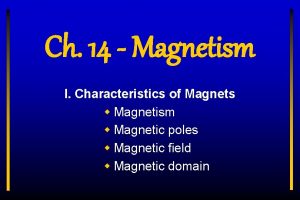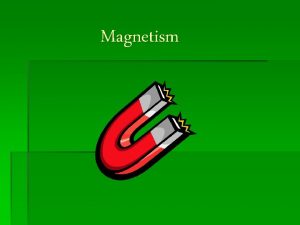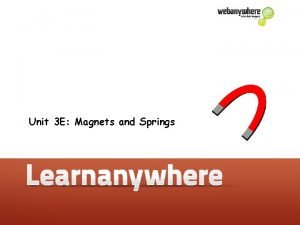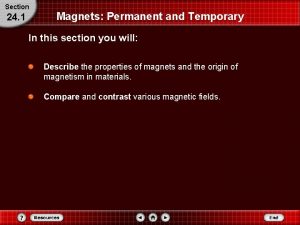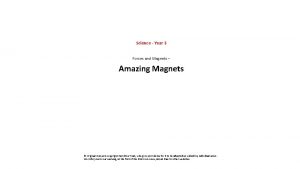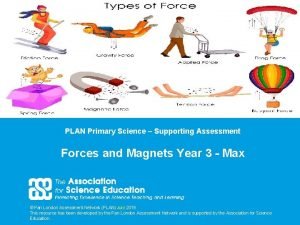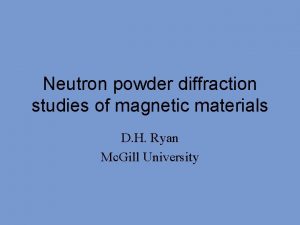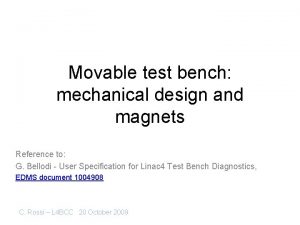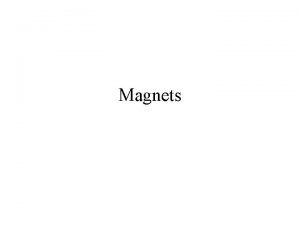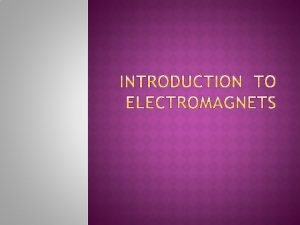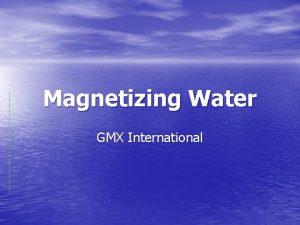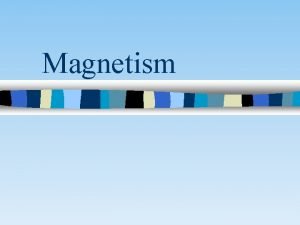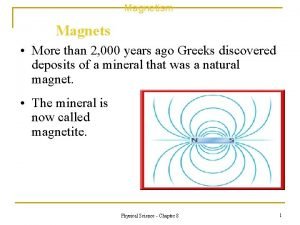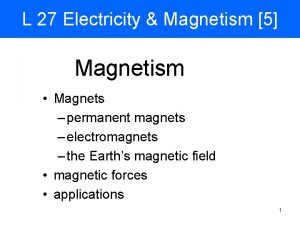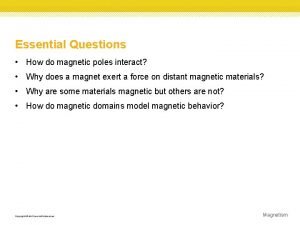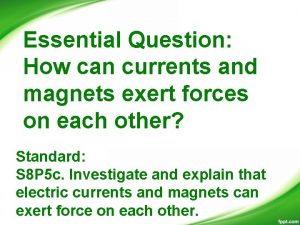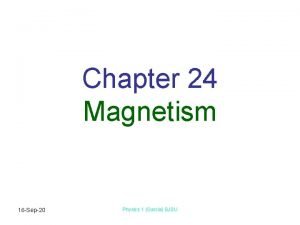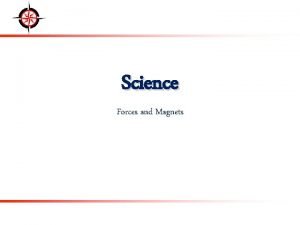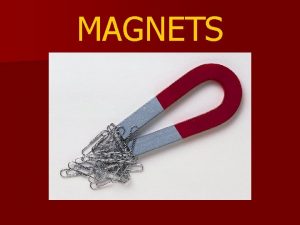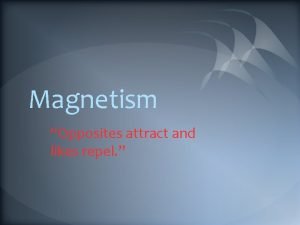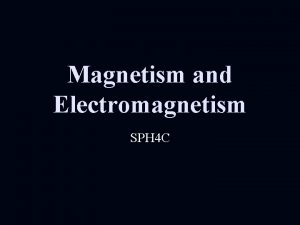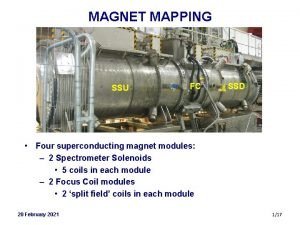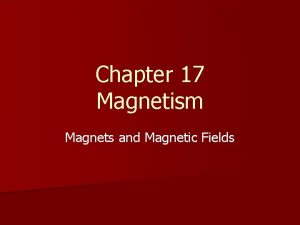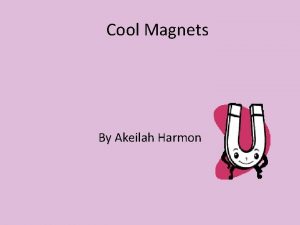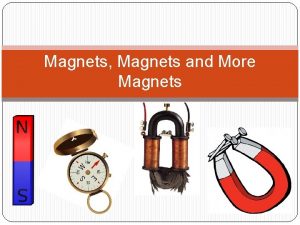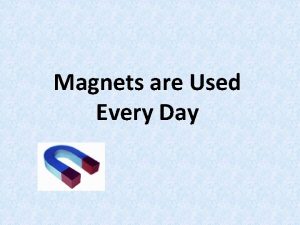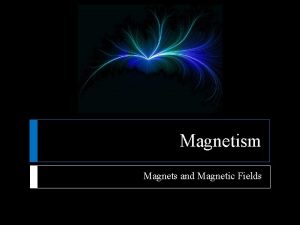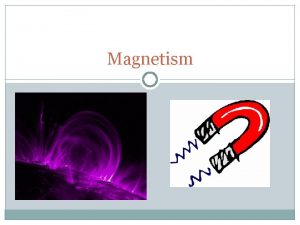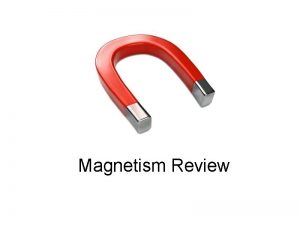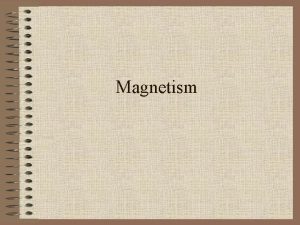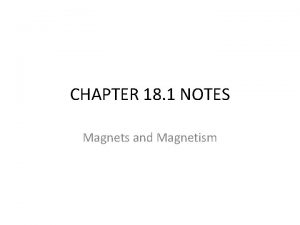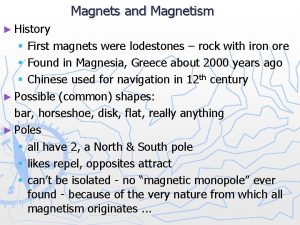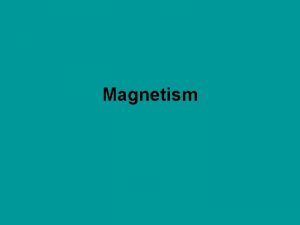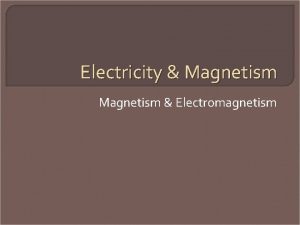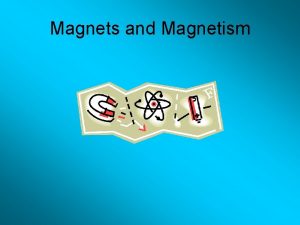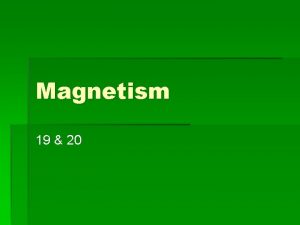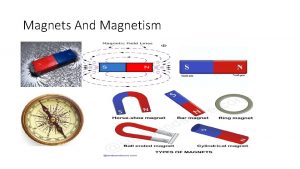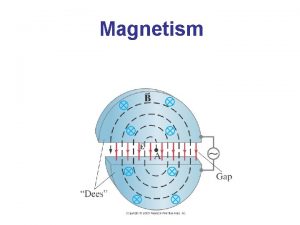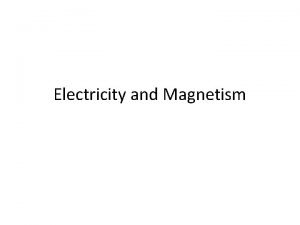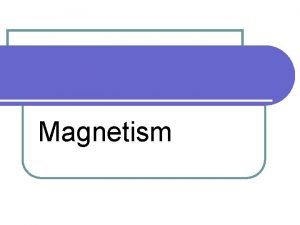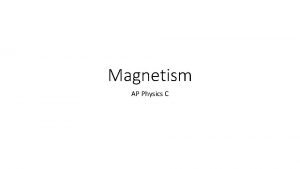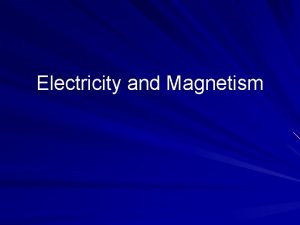Ch 14 Magnetism I Characteristics of Magnets w





























- Slides: 29

Ch. 14 - Magnetism I. Characteristics of Magnets w Magnetism w Magnetic poles w Magnetic field w Magnetic domain

A. Magnetism Ø Magnetism w force of attraction or repulsion between unlike or like poles w due to the arrangement of electrons w closely related to electricity

B. Magnetic Poles Ø Magnetic Poles w like poles repel w unlike poles attract w a broken magnet creates new poles

C. Magnetic Field Ø Magnetic Field w area around a magnet where magnetic forces act w field lines show direction of field (N S)

D. Magnetic Domain Ø Magnetic Domain w groups of atoms with aligned magnetic poles domain w in a magnetized object, domains are all aligned

Ch. 14 - Magnetism II. Uses of Magnetic Fields w Electromagnet w Speaker w Motor

A. Electromagnet Ø Electromagnet w strong, temporary magnet formed when current is passed through a coil of wire surrounding an iron core w acts like a bar magnet when current is on

B. Speaker Ø Speaker w electrical energy mechanical energy w wire coil moves back & forth as its magnetic field interacts with the field of a fixed magnet w forced vibration causes the cone to move sound

C. Motor Ø Motor w electrical energy mechanical energy w electromagnet rotates between the poles of a fixed magnet w commutator reverses the poles of the e’magnet

C. Motor assembled motor brushes & wires to battery armature & commutator field magnet

Ch. 14 - Magnetism III. Producing Electric Current w Electromagnetic Induction w Electric Generator w DC & AC w Transformer

A. Electromagnetic Induction Ø Electromagnetic Induction w producing a current by moving a wire through a magnetic field w some microphones work just like minispeakers in reverse w sound waves cause coil to move current Coil Dynamic Microphone

B. Electric Generator Ø Electric Generator w mechanical energy electrical energy w armature is rotated between magnet poles w magnetic field induces a current in the wire coil GENERATOR MOTOR

B. Electric Generator Ø Hydroelectric Dam w PE of lake water is converted to KE w mechanical KE turns the generator shaft which creates electrical energy

C. DC & AC Ø Direct Current (DC) w current flows in one direction w dry cells Ø Alternating Current (AC) w current reverses its direction at regular intervals w electrical outlets

D. Transformer Ø Transformer w increases or decreases AC voltage w primary coil AC produces a magnetic field that induces AC in the secondary coil w voltage ratio = ratio of turns in each coil

D. Transformer Ø Step-up Transformer w increases the voltage w more turns w power plants Ø Step-down Transformer w decreases the voltage w fewer turns w household appliances (hairdryers, etc. )

Ch. 15 - Light I. Electromagnetic Radiation Ø EM Spectrum Ø Types of EM Radiation

A. EM Radiation Ø Electromagnetic Radiation w transverse waves produced by the motion of electrically charged particles w does not require a medium w speed in a vacuum = 300, 000 km/s w electric and magnetic components are perpendicular

A. EM Radiation Ø Photons w tiny, particle-like bundles of radiation w absorbed and released by electrons w energy increases with wave frequency

B. EM Spectrum long short low f high f low energy high energy

C. Types of EM Radiation Ø Radiowaves w lowest energy EM radiation

C. Types of EM Radiation Ø Radiowaves w FM - frequency modulation w AM - amplitude modulation ØMicrowaves w penetrate food and vibrate water & fat molecules to produce thermal energy

C. Types of EM Radiation Ø Infrared Radiation (IR) w slightly lower energy than visible light w can raise thermal energy of objects w thermogram - image made by detecting IR radiation

C. Types of EM Radiation Ø Visible Light w small part of the spectrum we can see w ROY G. BIV colors in order of increasing energy red R O Y G. orange green yellow B blue I indigo V violet

C. Types of EM Radiation Ø Ultraviolet Radiation (UV) w slightly higher energy than visible light w Types: • UVA - tanning, wrinkles • UVB - sunburn, cancer • UVC - most harmful, sterilization

C. Types of EM Radiation Ø Ultraviolet Radiation (UV) w Ozone layer depletion = UV exposure!

C. Types of EM Radiation Ø X rays w higher energy than UV w can penetrate soft tissue, but not bones

C. Types of EM Radiation Ø Gamma rays w highest energy EM radiation w emitted by radioactive atoms w used to kill cancerous cells Radiation treatment using radioactive cobalt-60.
 Characteristics of magnetism
Characteristics of magnetism Characteristics of magnetism
Characteristics of magnetism Magnets for year 3
Magnets for year 3 Magnets and springs
Magnets and springs What happens when you break a magnet in half
What happens when you break a magnet in half Magnets attract and repel
Magnets attract and repel Why do magnets repel
Why do magnets repel 642008419
642008419 Amazing magnets
Amazing magnets Why do magnets repel
Why do magnets repel Temporary vs permanent magnets
Temporary vs permanent magnets Gmx magnets
Gmx magnets Natural magnets examples
Natural magnets examples Why do magnets repel
Why do magnets repel Iodestones
Iodestones Magnetism is invisible
Magnetism is invisible Magnetic field lines on a bar magnet
Magnetic field lines on a bar magnet The properties and interactions of magnets are called
The properties and interactions of magnets are called Scrap heap magnet circuit diagram
Scrap heap magnet circuit diagram How are permanent magnets formed
How are permanent magnets formed Why do magnets repel
Why do magnets repel How do currents and magnets exert forces on each other
How do currents and magnets exert forces on each other Mr garcia uses magnets
Mr garcia uses magnets Amazing magnets
Amazing magnets Fun with magnets mind map
Fun with magnets mind map What are magnets
What are magnets With magnets likes repel and opposites
With magnets likes repel and opposites Amazing magnets
Amazing magnets Ssu fc
Ssu fc Force exerted by magnetic field
Force exerted by magnetic field
